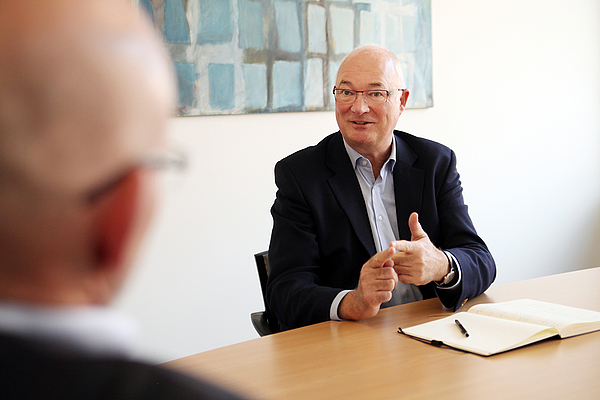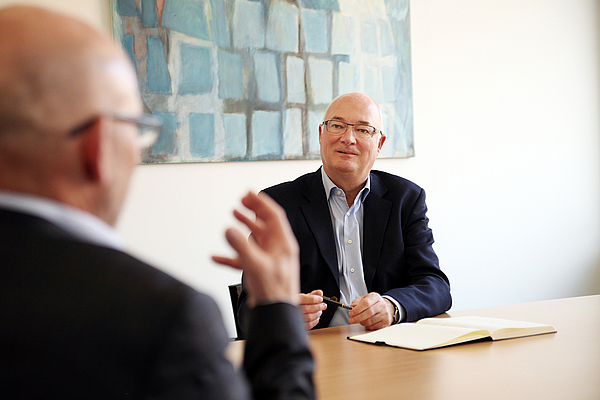
|

We Cannot Afford to Overlook the Opportunities the IoT Offersan Interview with Bernd Pätzold The Internet of Things and Industry 4.0 are casting doubt on existing business processes and business models. This revolution presents German companies with an opportunity they cannot afford to overlook, says Dr. Bernd Pätzold, CEO of PROSTEP AG, in this interview. Dr. Pätzold, how many intelligently networked devices do have in your household at the moment? In our two-person household, two computers, two iPads, two iPhones, an NAS server, two cars, the heating system and radiators, and the TV are connected to the Internet. Even our toothbrushes can exchange data via the Internet. If I've counted correctly, that is at least 13 devices, without including the countless virtual devices that we use in the form of services. This was not a deliberate decision on our part, it simply evolved. Do you sometimes have to explain to your friends what the Internet of Things and Industry 4.0 actually refer to? Pätzold: Yes, and sometimes also allay concerns fueled by reports in the media, such as the one in Focus about the threat to five million jobs. It is typical of us Germans that we always first see the risks instead of using our strengths to actively shape the changes and capitalize on them. Is the IoT just hype, as was the euphoria about CIM in the past, or is it really set to revolutionize our economy? Pätzold: I don't think that CIM was merely hype. The idea was just implemented differently than we had anticipated back then. When I switched to the private sector in 1990 after completing my doctorate, the automotive industry was on its knees. It had, however, accepted the challenge of lean manufacturing and radically changed the way it developed and manufactured products, which is certainly one of the reasons for its leading position today. PROSTEP was, by the way, a product of this revolution and has done well out of it. That's why I think it's fantastic that we are once again on the threshold of a fundamental change that offers our knowledge-oriented society outstanding opportunities. But we can't afford to overlook them because otherwise – as with almost every revolution – heads will roll, i.e. there will be winners and losers. Frage: What is actually so revolutionary about this industrial revolution? Networking is, after all, nothing new. Pätzold: It is networking of a different quality – we are moving from a hierarchical structure to a network of autonomous entities that interact intelligently. But what is revolutionary isn't actually the network itself but rather the fact that the devices collect and exchange data, which makes new services possible and thus shifts value creation. It is the data relating to the product and production that comprises the actual value as far as the customers are concerned. Here in Germany, the fourth industrial revolution is primarily taking place in the digital factory. Is that not a short-sighted way of looking at things? Pätzold: In this country, focus currently does lies predominately on the further development of our production processes. As important as this is, it doesn't mean that we can ignore the changes in the products and business models. Smart products, smart services and smart factories must all be developed simultaneously. What are the key technological drivers behind intelligent networking? Pätzold: I personally was impressed by the development of the Raspberry Pi Zero, a fully-fledged computer with half a gigabyte of main memory and a target price of five US dollars. If you add sensor technology, which is also becoming smaller and cheaper, you can provide very ordinary products with a great deal of intelligence. Combined with the next mobile telecommunications standard, G5, this opens up possibilities that we cannot yet completely comprehend. 

What impact will the IoT and Industry 4.0 have on the product development process? Will it have to be rethought? Yes, and I see two major challenges here. Firstly, the classic organizational structure of the companies will reach its limits because the process no longer ends with the SOP [Start of Production]. If devices are sold only as a service and are maintained by the manufacturer, the lifecycle doesn't actually end until the end of the service agreement. Take a smartphone, for example. Even after buying it, updates are provided by the manufacturer and ongoing personal customizing is performed via new apps. From the customer's perspective, the product continues to develop and that is what customers also expect from other products today. Secondly, courses for engineering, with its different disciplines, must be rethought along the lines of a systems engineering approach, so that optimum support can be provided for the development of these cyber-physical products and subsystems. We need more generalists – my thinking here goes in the direction of "all-round" engineers – and system architects so that we can master the challenges of the future. This is where the universities are called upon to take action. Doesn't this mean that PLM technology, which is the digital backbone of product development, also has to be reinvented? Pätzold: The classic PLM approach is based on the digital description of a product as a CAD model and its structure in the PDM system. We've already come a long way where the methodology for the description and the completeness of the digital representation are concerned. This approach, however, has its limitations when products are no longer differentiated by their physical components but only by the embedded software. I see a need for action and great potential when it comes to the further development of PLM. There is not so much a lack of software tools as the lack of a definition of the required processes and the supporting methodology. This is currently the number one topic as far as vendors and users are concerned What would you recommend that PLM vendors do? Should they now integrate all IoT platforms in their software? Pätzold:Every PLM vendor will have to find their own answers to this challenge in order to differentiate themselves from the competition. But PLM systems will in the future certainly have to provide better support for model-based systems engineering, lifecycle-oriented configuration management and application lifecycle management than they do today. Frage: What challenges does PROSTEP AG face as a consulting company and provider of integration solutions? Pätzold: The IoT and Industry 4.0 will mean dramatic changes for our customers. Thanks to our wide-ranging consulting expertise and our many years of experience with PLM integration and implementation, we are fully equipped to provide them with support they need. Our involvement in numerous of the ProSTEP iViP Association's research projects and initiatives means that we always have a finger on the pulse of the future. It's no coincidence that our motto is INTEGRATE THE FUTURE. Politicians fear that the Internet could destroy millions of jobs. Will PROSTEP be reducing the number of its employees? Pätzold: The IoT and Industry 4.0 will certainly have a negative impact on employment when it comes to lower-skilled jobs, especially in production. But that was also the case before the invention of the IoT. Think about how many travel agencies have disappeared from the market since the Internet made it easy for people to book their own flights, hotels, train tickets, etc. On the other hand, the trend towards new "product-as-a-service" offerings means that more staff is needed in the service sector, even here in high-wage countries, and it creates new jobs. As far as PROSTEP itself is concerned, the impact on employment is positive. We are not only constantly looking for experienced consultants, software architects and project managers but also young people with innovative ideas who are in the process of launching their careers. Dr. Pätzold, thank you very much for talking to me. (This interview was conducted by Michael Wendenburg) |
|
| © PROSTEP AG | ALL RIGHTS RESERVED | IMPRESSUM | DATENSCHUTZERKLÄRUNG | HIER KÖNNEN SIE DEN NEWSLETTER ABBESTELLEN. |
